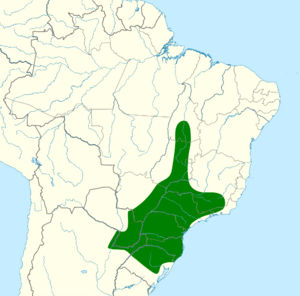Surucua trogon facts for kids
Quick facts for kids Surucua trogon |
|
|---|---|
 |
|
| male Trogon s. surrucura | |
| Conservation status | |
| Scientific classification | |
| Genus: |
Trogon
|
| Species: |
surrucura
|
 |
|
The Surucua Trogon (Trogon surrucura) is a very colorful bird. It lives in the forests of South America. This bird is part of the Trogonidae family, which also includes the famous quetzals. Surucua Trogons are known for their bright feathers and interesting calls. You can find them in countries like Argentina, Brazil, Paraguay, and Uruguay.
Contents
About Surucua Trogons
Scientists like to group living things to understand them better. For the Surucua Trogon, there are two main types, or "subspecies." They are called T. s. surrucura and T. s. aurantius. Some bird experts even think these two types are different species entirely! It's like having different versions of the same car model.
What Does a Surucua Trogon Look Like?
Surucua Trogons are medium-sized birds. They are usually about 26 to 28 centimeters (10 to 11 inches) long. They weigh between 56 and 78 grams (about 2 to 2.7 ounces).
- Male Surucua Trogons*
The male T. s. surrucura has a blackish face and throat. It has a bright orange ring around its eye. Its head, neck, and chest are a beautiful royal blue. The back is a shiny coppery green. This color changes to turquoise-green on the top of its tail. When its wings are folded, they look gray. The belly is pinkish-red, and the sides are gray. The underside of the tail is white with a black bar at the end.
- Female Surucua Trogons*
The female T. s. surrucura is mostly gray. Her red belly starts a bit lower than the male's. Instead of an orange eye ring, she has small white spots near her eyes. The underside of her tail has a black and white pattern.
- Differences in T. s. aurantius*
The T. s. aurantius subspecies is about 28 centimeters (11 inches) long. The male of this type has a yellow eye ring instead of orange. Its belly is orange, not pinkish-red. The female's belly is yellowish-white to orange-yellow.
Where Surucua Trogons Live
The T. s. surrucura subspecies lives in eastern Paraguay and northeastern Argentina. It also lives east into Uruguay and in Brazil. In Brazil, it can be found as far north as southeastern Tocantins.
The T. s. aurantius subspecies lives in a smaller area. It is found in east-central and eastern Brazil. This includes areas from Bahia south to São Paulo state.
- Their Forest Homes*
These birds like to live in the middle parts of tall, old forests. They also live in well-developed younger forests and woodlands where some trees lose their leaves. The T. s. aurantius often hangs out near bamboo plants.
T. s. surrucura can be found at heights up to 1,150 meters (3,770 feet) in Bahia. They live even higher in other states, sometimes over 1,550 meters (5,085 feet). T. s. aurantius can live up to about 2,000 meters (6,560 feet) high.
Surucua Trogon Behavior
Do They Migrate?
The T. s. aurantius subspecies usually stays in its home area all year. The T. s. surrucura subspecies mostly stays put too. However, the birds that live furthest south might move north during the Southern Hemisphere's winter.
What Do They Eat?
Surucua Trogons eat many different things. Their diet includes a wide variety of insects, both adult bugs and their larvae. They also enjoy eating fruits and sometimes flowers. Sometimes, they will join groups of different bird species that are all looking for food together.
Reproduction
The breeding season for the Surucua Trogon is from September to December. It might even go into January. They build their nests in holes found in decayed trees. They also use nests made by tree-dwelling termites. One nest that was studied had three eggs.
What Do They Sound Like?
The song of the Surucua Trogon is a series of notes that get a little louder as they go up. It sounds like 14 to 20 full "diu" or "kwa" notes. They also make a "kiarr" sound when they want to warn others about danger.
Surucua Trogon Status
The IUCN (International Union for Conservation of Nature) keeps track of how many animals are left in the wild. They say that both types of Surucua Trogons are of "Least Concern." This means they are not currently in danger of disappearing.
However, scientists have not counted exactly how many of these birds there are. They believe the number of both subspecies is slowly going down. Both types of Surucua Trogons live in special protected areas. But outside these areas, their homes are being broken up by people cutting down forests.


